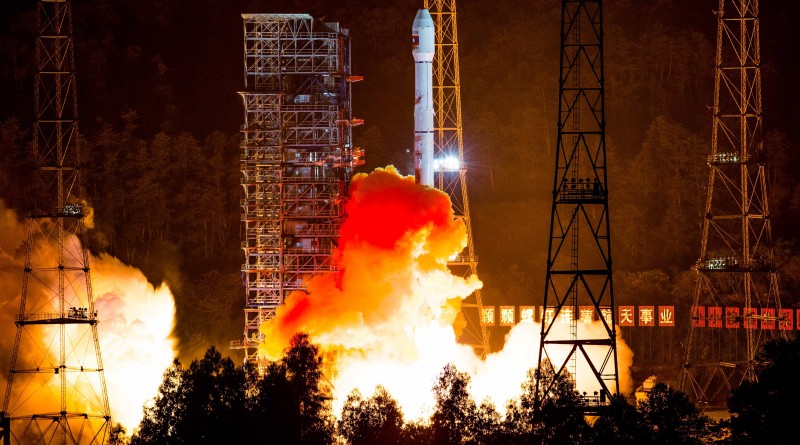China conducts Year-Opening Launch with Belarusian Communications Satellite
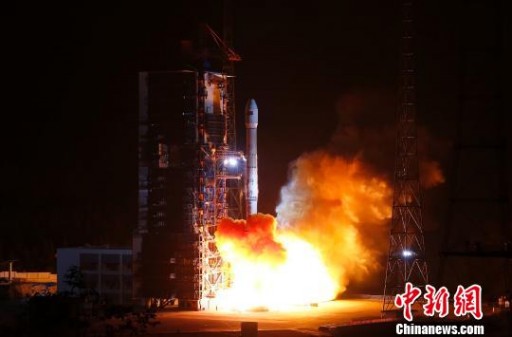
China opened a busy year of space launches on Friday with the successful launch of a Long March 3B rocket carrying the Belintersat-1 communications satellite to Geostationary Transfer Orbit to become the first Belarusian communications satellite. Lifting off from LC3 at the Xichang Satellite Launch Center at 16:57 UTC, Long March 3B conducted a successful ascent mission lasting a little under half an hour to drop the satellite off in its target orbit.
Belintersat-1 is based on the Chinese DFH-4 satellite bus while the communications payload was supplied by Thales Alenia Space, based in Europe. The satellite builds the centerpiece of the National System of Satellite Communication and Broadcast of the Republic of Belarus – an initiative considered to be of innovative, economic, social and political importance for the country. The Belintersat project will deliver a number of services for which great demand exists in Belarus, specifically satellite internet, mobile satellite communications, services for mobile operators, networking solutions for corporate customers and TV broadcasting.
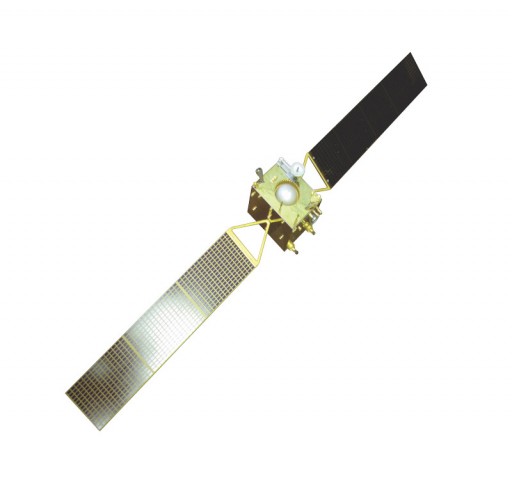
The project has a number of objectives ranging from the operation of a communications satellite to providing modern communications technology and services to remote areas. The Belarusian government awarded the contract for the Belintersat-1 mission to the China Great Wall Industry Corporation that offers Chinese satellites and launch services on the commercial market. Under the contract, the satellite platform would be manufactured by the China Academy of Space Technology (CAST) and launched by a CZ-3B rocket provided by the China Academy of Launch Vehicle Technology (CALT). Responsible for the initial testing and in-orbit commissioning of the satellite is China Satellite Launch & Tracking Control General.
Commercial satellite operator NigComSat headquartered in Nigeria won the bid for in-orbit testing and carrier spectrum monitoring services for the Belintersat-1 mission payload.
The DFH-4 bus represents the third generation communications satellite platform, capable of facilitating high-power and high-capacity communications payloads for different applications such as direct broadcasting, tracking and data relay, mobile communications, etc.
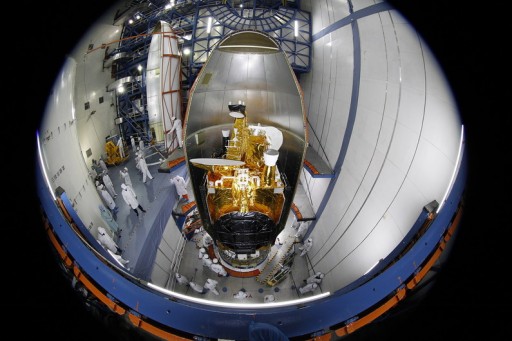
DFH-4 measures 2.36 by 2.10 by 3.60 meters in dimensions and can accommodate payloads of up to 588 Kilograms, creating a launch mass of a maximum of 5,200 Kilograms. Two 6-meter solar arrays generate an End-of-Life power of 10,500 Watts of which 8kW are available to the payload. DFH-4 is divided into three modules – the propulsion module, the service module and the payload module. Onboard batteries are used to store power for night passes and power distribution is provided by dedicated avionics systems.
The DFH-4 satellite platform uses state of the art navigation and attitude determination systems and reaction wheel-based attitude actuation. The satellite is equipped with a main propulsion system for the climb to Geostationary Orbit and reaction control thrusters used to assist in attitude control and stationkeeping in the Geostationary Belt that is possible with an accuracy of +/-0.05° in all directions.
The communications payload installed on Belintersat-1 is comprised of 20 C-Band transponders operating at 36 MHz, 18 standard 36 MHz Ku-Band transponders and four enhanced 54 MHz Ku-Band transponders. Three C-Band coverage zones are provided by the satellite – an African, a European and a global beam while Ku Coverage is focused on Europe and Africa with the enhanced Ku transponders catered to deliver services to the Belarusian territory. A subset of the satellite’s transponders have been leased to China Satcom, marketed under the ChinaSat-15 designation.
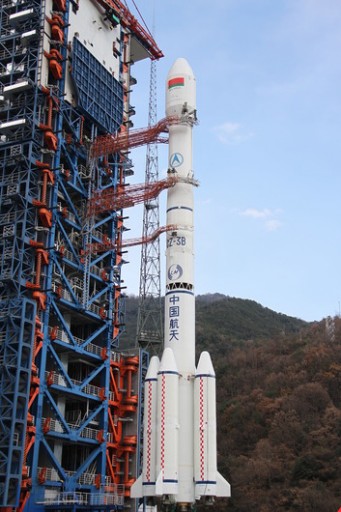
Belintersat-1 will be stationed at 51.5 degrees East in Geostationary Orbit and has a life expectancy of 15 years.
Long March 3B/E weighs approximately 456,000 Kilograms and stands 56.33 meters tall with a core diameter of 3.35 meters. The four boosters, first and second stage use storable propellants, Unsymmetrical Dimethylhydrazine and Nitrogen Tetroxide while the third stage uses cryogenic propellants, Liquid Hydrogen and Liquid Oxygen.
Liftoff was preceded by an eight-hour countdown operation during which the Long March 3B rocket was powered up and underwent final testing before heading into propellant loading on the cryogenic third stage around seven hours prior to T-0, filling the stage with 18,200 Kilograms of Liquid Oxygen and Liquid Hydrogen that were kept topped up until late in the countdown.
The boosters and two lower stages of the rocket received their propellant load before the countdown along with the attitude control system of the third stage since all these systems use storable propellants. Overall, the launcher was filled with 400 metric tons of Unsymmetrical Dimethylhydrazine and Nitrogen Tetroxide to be used by the boosters, the core stage and second stage in the first minutes of flight.
At 16:57:00 UTC, Long March 3B/E ignited its boosters and core stage that soared to a collective liftoff thrust of 604 metric-ton-force. Thundering off four seconds later, the rocket rose from its pad, lighting up the night skies over the Xichang launch base in the Sichuan province in south-western China. After a vertical ascent of a few seconds, the rocket began to pitch and roll onto its planned ascent path, taking it south-east across China before passing over the Pacific Ocean.
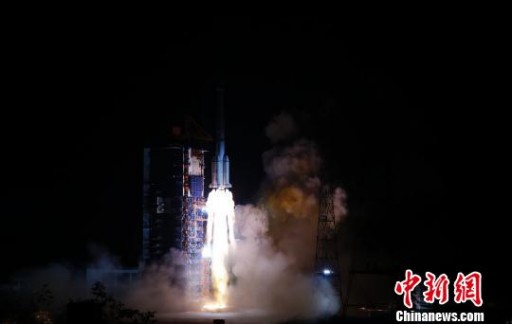
With all engines firing at full throttle, Long March 3B/E burned 2,350 Kilograms of propellant per second as it started racing uphill and making its way downrange, passing Mach 1 and encountering Maximum Aerodynamic Pressure. Each of the four boosters delivered 75,500 Kilogram-force of additional thrust to the vehicle using a single DaFY-5-1 engine. The boosters consumed their propellant load of 41,200kg, each, over the course of a burn of 140 seconds after which they dropped away from the three-stage rocket.
With the boosters gone, the Core Stage continued powering the vehicle using a DaFY-6-1 cluster of four engines delivering 302 metric tons of thrust. Overall, the 24.8-meter tall first stage launched with a propellant load of 186,200 Kilograms that was expended in two minutes and 38 seconds. Immediately after engine cutoff of the first stage, the second stage commanded its four-chamber vernier engine of the second stage to ignite as part of the hot-staging sequence employed by the Long March 3B.
A series of 14 pyrotechnic bolts were fired to disconnect the first and second stage, allowing the second stage’s vernier engine to move the stack away from the empty core stage. Moments after staging, the second stage ignited its DaFY-20-1 main engine, soaring up to a full thrust of 75,660 Kilogram-force to continue powered ascent. The second stage was controlled by using the four-chamber vernier engine that added another five metric tons of thrust. Overall, the second stage launched with a propellant load of 49,400 Kilograms measuring 12.92 meters in length and 3.35 meters in diameter.
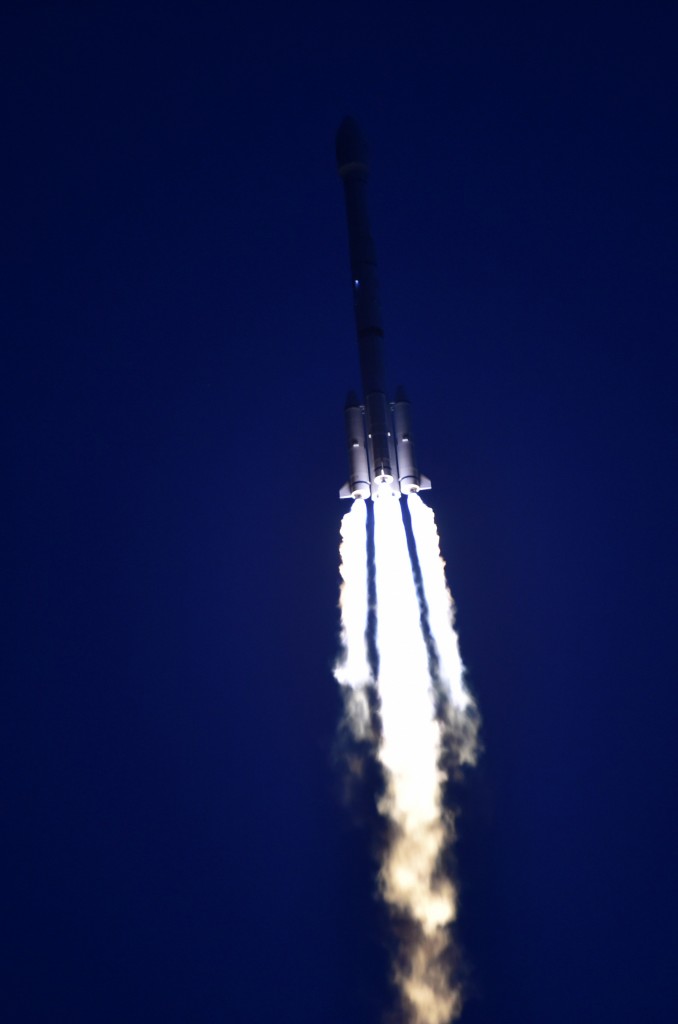
While the second stage was firing, Long March 3B departed the dense atmosphere, making it safe to jettison the protective payload fairing and expose the Belintersat-1 satellite for the rest of its ride uphill.
The second stage performed a nominal burn of 178 seconds with the vernier engine burning about six seconds longer than the main engine. Second stage cutoff occurred after the mission passed T+5.5 minutes. Immediately after shutdown, the pyrotechnic stage separation system was initiated and solid-fueled retrorockets moved the second stage away.
One second after staging, the third stage ignited its two cryogenic YF-75 engines. The 12.38-meter long third stage delivered a total thrust of 16,000 Kilogram-force as part of its initial burn to accelerate the stack to orbital velocity in order to enter a Low Earth Parking Orbit.
The Low Earth Parking orbit, around 190 Kilometers in altitude, was reached after a third stage burn of around four minutes and 45 seconds, marking the start of a coast phase. The coast phase, nearly 11 minutes in duration, was set up to allow the stack to fly to a position where the second burn could be performed around the equator passage so that the high-point of the orbit would be placed over the equator. This second burn lasted for approximately three minutes and 15 seconds and was followed by a variable velocity adjustment that involved the vernier engines of the third stage which continued to fire until the navigation platform sensed that the targeted injection velocity was achieved, thus optimizing the accuracy of the orbital insertion.
Separation of the Belintersat-1 satellite was expected just after T+26 minutes and was declared a success by Chinese officials.
The Joint Space Operations Center tracked two objects related to this launch in the expected Geostationary Transfer Orbit:
2016-001A - 197 x 41,781 km - 26.38° [Belintersat-1] 2016-001B - 158 x 39,804 km - 26.27° [Long March 3B Third Stage]
In the coming days and weeks, the satellite will complete its transfer to Geostationary Orbit and take up station where it will complete in-orbit testing and commissioning before entering operational service for a mission of at least 15 years.

